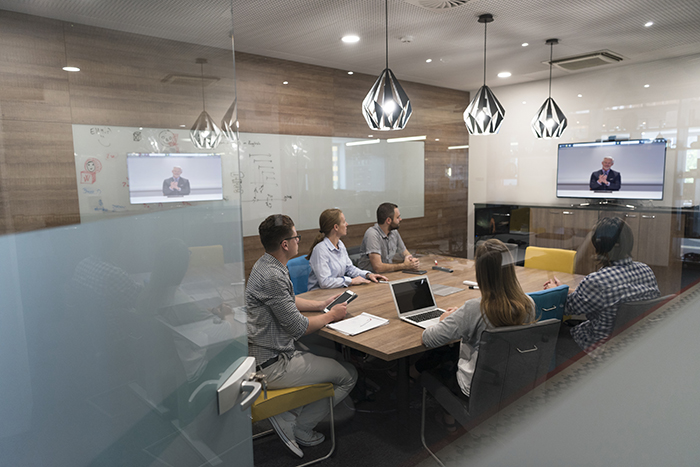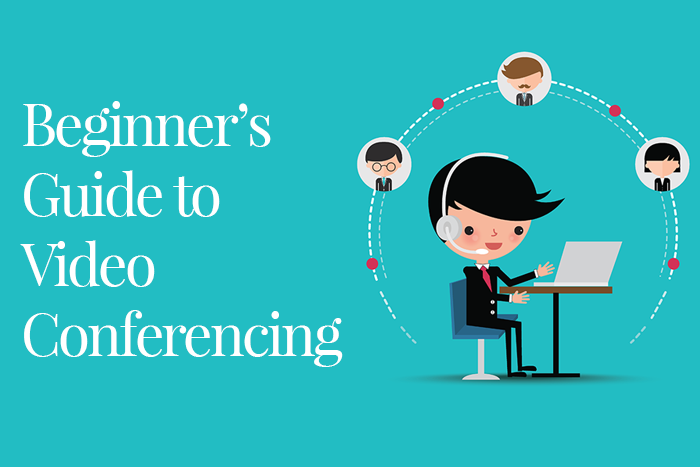Beginner’s Guide to Video Conferencing
Video conferencing is an addition to the numerous ways you can use video in your business. It allows people to connect authentically because of the power of audio and video technology.
The Beginner’s Guide to Video Conferencing will explain the what, why and how and provide details to help you get started.

What is Video Conferencing?
Video conferencing, or VC for short, lets people from anywhere in the world to connect into a conversation with two or more people using audio and video technologies. It can also be achieved using any mobile device connected to the internet.
It allows a person to listen, talk and see other participants on the call through technologies such as; microphones, conference phones, speakers, webcams, computer or even your smartphone device.

Benefits
There are many advantages of video conferencing, and they include:
Increasing Productivity
Video conferencing gives attendees the freedom to stay put and in a hands-free environment, leaving them open to continue their work before and after the video conference with minimal interruption.
Additionally, meetings held via video conference give remote teams the opportunity to work and get things done collaboratively.
Alternative to in-person meetings
Just a few years ago, in-person meetings were the norm. Now, through the power of video conferencing, you still have the “in-person” feel without the need to leave the comfort of your home or office. Furthermore, it provides all parties the ability to connect at a moments notice. This is in contrast to the scheduling and preparation needed for in-person meetings.
Eliminates the need for travel
In 2015, Business Travel News reported an average business trip daily cost of $306.91! With transportation costs on the rise, video conferencing is a cost-efficient substitute.
Scalable up to 5000 participants
Video conference calls are scalable up to 5000 attendees. Because of that capability to fluctuate between 5 members and 5000, video conferencing is a viable option for nearly any situation. You can have one-on-one conversations, small group meetings or engage thousands of people with the same technology.
Keeps participants engaged
One of the biggest problems with any group conversation or meeting is keeping people engaged. With video conferencing technology, it keeps participants involved because they’re on camera and actively participating in the discussion.
Accessibility
You can connect to a video conference quickly using your desktop, laptop or mobile device.

Uses of Video Conferencing
Video conferencing is a useful tool when you need to communicate clearly. As a result, it is utilized in a variety of ways by a variety of industries including:
Education
Video conferencing opens up new opportunities in education from teaching online courses to distant learning. As a result, students now have the ability to work collaboratively and communicate directly with classmates and the instructor. Also, it opens up the potential to educate students around the world.
Visit our post on creative ways to use video conferencing in the classroom for more information.
Business
There is business travel, and then there is business travel. Sometimes, it is an enjoyable experience, while other times, it is inconvenient, costly and takes a serious toll on your productivity. Therefore, video conferencing is quickly becoming one of the most welcome changes to the way we do business.
Training
In 2014, Training Magazine reported 61.8 billion spent annually in the U.S. As one of the most expensive business expenditures, training new employees through video conferencing is quickly becoming the “go-to” for cost effective training.
Government
There are numerous uses for video conferencing in the government sector. Local, state and federal agencies can benefit from video collaboration because they can assist in streamlining processes and making administration more efficient.

Video Conferencing Equipment
Video conferencing requires some basic audio and visual tools including:
Camera
Selecting the right webcam can make the difference between a brilliant visual experience where you can see every detail to a blurry resolution and laggy streaming experience. Check out the best webcams of 2017 to find the option that is right for you.
Microphone
Microphones has an enormous impact on audio quality. As a result, you will want to be a little picky when choosing the right one for you. The important features you will want to watch for are the type of microphone and their polar patterns. Polar patterns are modes on the microphone that will allow sound to be picked up in specific directions.
To learn more about polar patterns and to find out which microphones are best overall, check out Slicktechies guide.
On a related note, my personal recommendation is a Blue Yeti or Blue Snowball. Both microphones provide studio-quality audio and have multiple polar patterns which make either microphone work for any situation. They are also super affordable and I would recommend them to anyone because of the truly excellent quality.
Speakers & Headsets
PC Mag recently reviewed the best wireless speakers of 2017 which included Amazon Echo, Sonos Play, Vifa Oslo and others. I would recommend reading their article to find the right speakers that will fit your needs and check out their very detailed, accurate reviews.
Alternatively, a headset can provide noise-cancelling features, excellent sound quality, and wireless features. For more information, visit TechRadar’s post which uncovers the best headphones and earphones for teleconference and video calling.
Mobile Device
Most smartphones and tablets with internet access can be used for video conferencing. So, visit the Apple App Store or Google Play Store, to download the app that corresponds to your video conferencing software. For browser-based platforms, you can open a web browser or follow a link to the conference.
If you are just getting started with video conferencing and need enterprise-level equipment, check out The VideoConference Store. They supply new and refurbished conferencing equipment at competitive prices.
Conclusion
The possibilities for video conferencing are endless. Right now, we are just beginning to scratch the surface of what we can do with it. Especially the implications it has for business, education and government sectors. It will be exciting to see what video conferencing holds for us in the future.
I would love to hear your thoughts on video conferencing and how it can benefit different industries. Drop a comment below and share. =)






One Comment
Comments are closed.